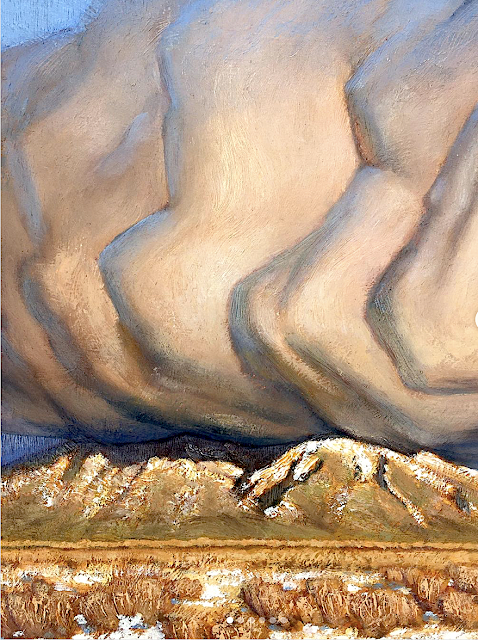ERNEST L. BLUMENSCHEIN (1874-1960)
Picuris Mountains (2,967 m - 9,734 feet)
United States of America (New Mexico)
In Picuris Mountain (Near Taos), ca. 1940, oil on canvas, Smithsonian American Art Museum
The mountains
Picuris Mountains (2,967 m - 9,734 feet) is one of the Ridge in Taos County, nearby Osha Canyon and Vallecitos. Named Pikuria – those who paint – by Spanish colonizer Juan de Oñate, Picuris is located 24 miles (38 km) southeast of Taos in the Sangre de Cristo Mountains via N.M. 68, 518, and 75. Picuris, once the largest, today is one of the smallest Tiwa pueblos, with some 1,801 inhabitants (Census 2000). Like Taos, it was influenced by Plains Indian culture, particularly the Apaches
If one like biking, the ride takes you into the scenic and historic part of Picuris Mountains. About 2 miles from the start of this ride you will cross the historic Camino Real, or “Royal Highway,” that served as the original highway to Taos for traders, settlers, and Native Americans traveling north and south for several hundred years.
In late spring through fall this ride is free of snow and dry. It can be pretty beastly pushing up this mountain in the middle of summer. Plan on riding early or late in the day to avoid the heat.
The Painter
Ernest Leonard Blumenschein was an American artist and founding member of the Taos Society of Artists. He is noted for paintings of Native Americans, New Mexico and the American Southwest.
Ernest Blumenschein began in arts by studying violin at the Cincinnati College of Music, but after working as an illustrator for his high school newspaper, he sensed that he had found his calling. To pay for courses at the Art Students League, he played for the New York Symphony for two years, under the direction of the Czech composer Anton Dvorák himself ! He saved enough money to move to Paris to sharpen his painting skills at the Adadémie Julian.
Back in the United States, an assignment for McClure’s Magazine took him to Taos, New Mexico, for the first time. Charmed by the Southwest, Blumenschein eventually settled there along with other East Coast artists who had grown tired of life in the city.
As Blumenschein later recalled,
“We all drifted into Taos like skilled hands looking for a good steady job . . . We lived only to paint. And that is what happens to every artist who passes this way.” (Henning, ed., Ernest L. Blumenschein Retrospective, 1978)
Ib a letter dated 1901 he wrote :
"I am wildly enthusiastic over my surroundings. Everything about me is inspiring me to work. Great mountain ranges that become as clear to one as a friend, landscapes, big and beautiful, deserts reflecting a vast sky, and you feel you are part of it all and are never alone.” in Paintings of the American Southwest, The Arvin Gottlieb Collection, brochure, National Museum of American Art, 1995
The style of painting of the Taos painters was to decisively influence the perceptions that the wider world came to have of the American Southwest, specifically of the Pueblo and Navajo Indian peoples.
During World War I, Blumenschein led a national effort to produce range-finder paintings used to help train military gunners.
Paintings by Blumenschein are held in the Eiteljorg Museum of American Indians and Western Art in Indianapolis, Indiana, the Harwood Museum of Art in Taos, the Taos Art Museum and Fechin House, the New Mexico Museum of Art in Santa Fe, and the El Paso Art Museum in El Paso, Texas.




